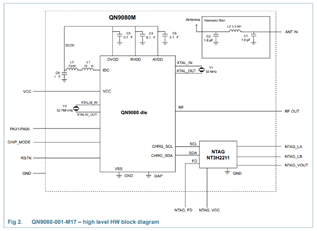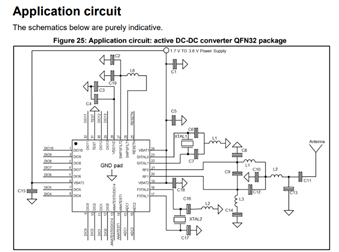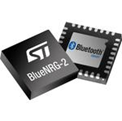Electronics have advanced by leaps and bounds in the past decade with the rise of IoT, the increase in connectivity, and the desire for devices to continue to be more powerful and portable. Now that even the most mundane devices are expected to have some sort of wireless connectivity, how can RF modules help designers and why are they potentially more preferred?
Modules vs. modules
While somewhat confusing, the term “module” can cover multiple types of devices, and it is important to recognize the differences between them. When engineers talk about modules, they often refer to a small, pre-fabricated device that can be slotted into a design with no external parts required to make that device work (i.e., they are almost an all-in-one package).
For example, the QN9080-001 is a Bluetooth module that includes multiple silicon dice, an antenna, and all passive components internally needed to make it function (see the diagram below). However, the term “module” can also refer to devices that can interface with a microcontroller or processor to provide “add-ons” and functionality.
Case in point: The BLUENRG-232 Bluetooth SoC integrates all of the silicon needed to create a Bluetooth-enabled system but does not include the external antenna, power circuitry, and passive components needed to make it function correctly.




QN9080M module with all passives internal against the BlueNRG-232, which needs components
Advantages of full modules
To simplify our discourse, in this article, “full modules” will refer to those that include all of the components to make them function correctly (such as the QN9080M). These types of modules are often more expensive than single-chip modules (such as the BlueNRG-232), as they integrate multiple dice, a small PCB, and external components. However, by doing so, they can drastically reduce the time for prototype development. Reduced development time offsets the price adder while affording one’s organization a competitive advantage: being fast – if not first – to market.
There are several advantages to using full modules:
- Eliminates the need for an engineer to learn about hardware requirements (antenna design, etc.)
- Designed by the manufacturer who has the best inside knowledge of the device and will therefore result in the best performance of the device
- Are often available on reels and, by integrating all of the required passive components, can result in quicker product manufacturing times by reducing part counts
- Pre-made modules can, in many instances, be used as standalone processors, which can remove the need for an external microcontroller or processor, with many pre-fabricated modules including Arm cores, ADC, DAC, SPI, I2C, and UART.
However, one of the biggest reasons for designers to use full modules is that many are designed and checked to conform to CE and FCC standards. This dramatically improves the end product’s chances to also pass CE and FCC regulations. Designing products comes with many difficulties with CE and FCC regulations, as well as the cost of a failing device—potentially months of extra design work and more money needed to perform further CE and FCC testing.
Advantages of chip modules
The other type of module that is available to design engineers is the “chip” variety. Unlike full modules, these do not include the peripheral passive components or other hardware required to make them function. Design engineers need to consider what passive components are needed, how to design a PCB or external antenna, and be cautious of EMC considerations.
But the use of chip modules can be very beneficial if done correctly and, in some instances, can be more desirable than full modules. Unlike full modules, chip modules allow designers more control over the design, which can result in significant reduction in PCB size and, therefore, cost. While external passive components and an antenna need to be accounted for, the cost of the chip module and these external parts will almost always be cheaper than their full-module counterparts.
Another advantage to using chip modules is that not all full modules are FCC- and CE-certified, which can cause designers problems if the full module inherently violates EMC regulations. The use of a chip module allows designers to use all kinds of EMC-reducing techniques, including curved traces, stitching vias, ground pours, and trace-length matching, whereas a pre-made module may not use these practices.
Chip modules can often be used as a single-chip solution for a product and integrate most standard peripherals, including I2C, SPI, GPIO, ADC, DAC, I2S, and UART. This eliminates the need for other microcontrollers and processors, significantly improving total BOM cost. It can also reduce development time because the PCB will contain fewer parts and only one microcontroller is being programmed.
Which one to pick?
The type of module that you choose for your next product can depend on a few things, so to make the choice easier, the table below lists each device type and their advantages/disadvantages:
|
Category |
Chip Modules |
Pre-Made Modules |
Preferred Device |
|
Price |
$ |
$$$ |
Chip |
|
Complexity |
Complex |
Simple |
Pre-fabricated |
|
Size |
Small |
Large |
Chip |
|
EMC |
Complex—requires careful antenna routing |
Simple—some modules are EMC-compliant |
Pre-fabricated if already certified |
|
Design Time |
Long and potentially difficult |
Quick—drop-in placement |
Pre-fabricated |
|
Applications |
Large-scale production Portable applications
|
Prototyping Quick-to-production Small-volume |
— |
|
Example Devices |
BGX13S22GA BLUENRG-232 |
QN9080-001-M17AZ |
— |


